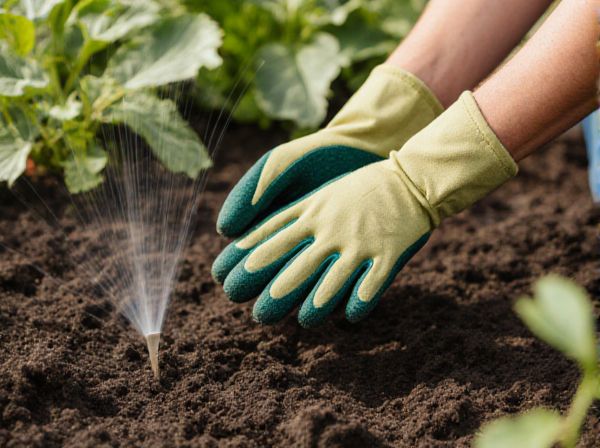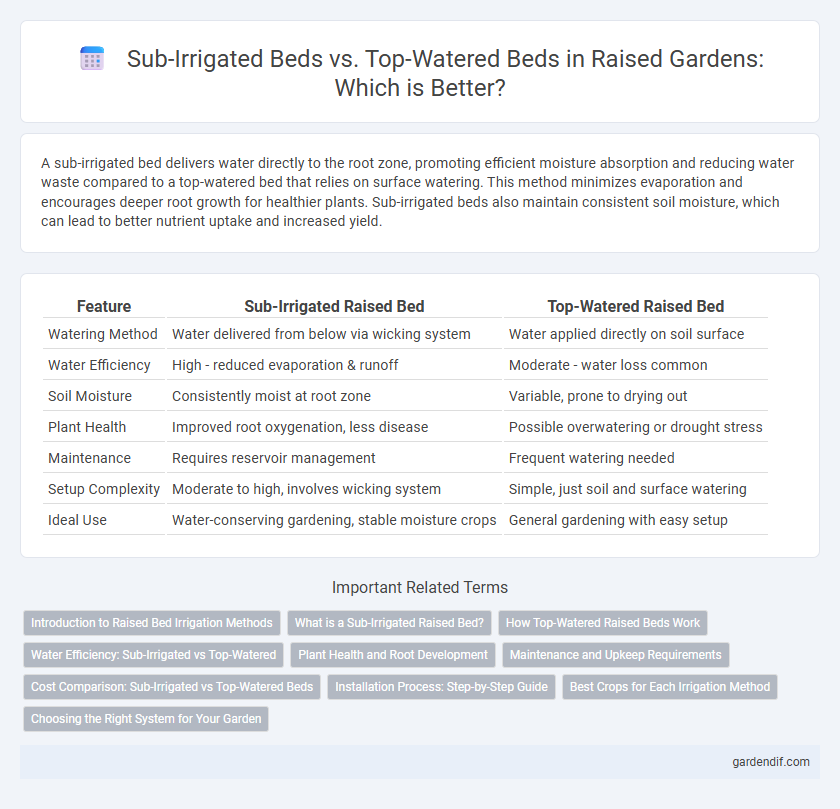
Sub-irrigated bed vs Top-watered bed Illustration
A sub-irrigated bed delivers water directly to the root zone, promoting efficient moisture absorption and reducing water waste compared to a top-watered bed that relies on surface watering. This method minimizes evaporation and encourages deeper root growth for healthier plants. Sub-irrigated beds also maintain consistent soil moisture, which can lead to better nutrient uptake and increased yield.
Table of Comparison
| Feature | Sub-Irrigated Raised Bed | Top-Watered Raised Bed |
|---|---|---|
| Watering Method | Water delivered from below via wicking system | Water applied directly on soil surface |
| Water Efficiency | High - reduced evaporation & runoff | Moderate - water loss common |
| Soil Moisture | Consistently moist at root zone | Variable, prone to drying out |
| Plant Health | Improved root oxygenation, less disease | Possible overwatering or drought stress |
| Maintenance | Requires reservoir management | Frequent watering needed |
| Setup Complexity | Moderate to high, involves wicking system | Simple, just soil and surface watering |
| Ideal Use | Water-conserving gardening, stable moisture crops | General gardening with easy setup |
Introduction to Raised Bed Irrigation Methods
Sub-irrigated raised beds deliver water directly to plant roots through a controlled reservoir, enhancing water efficiency and reducing evaporation. Top-watered beds rely on surface irrigation, frequently requiring more water and increasing the risk of runoff and soil erosion. Understanding these irrigation methods is essential for optimizing moisture levels and improving plant health in raised bed gardening.
What is a Sub-Irrigated Raised Bed?
A sub-irrigated raised bed (SIRB) is a gardening system designed to deliver water directly to plant roots through a reservoir located beneath the soil, promoting efficient water use and reducing evaporation. This method contrasts with top-watered beds, where water is applied from above, often leading to surface runoff and uneven moisture distribution. SIRBs maintain consistent soil moisture levels, enhancing plant growth and minimizing water waste in raised bed gardening.
How Top-Watered Raised Beds Work
Top-watered raised beds rely on delivering water directly to the soil surface, allowing it to penetrate downward through irrigation or manual watering. This method depends on consistent watering schedules to maintain adequate moisture levels for plant roots, often requiring more frequent attention to prevent drying out. Unlike sub-irrigated beds, top-watered beds can experience surface evaporation and runoff, impacting water efficiency.
Water Efficiency: Sub-Irrigated vs Top-Watered
Sub-irrigated beds deliver water directly to the root zone through a reservoir, reducing evaporation and runoff, which enhances water use efficiency by up to 50% compared to top-watered beds. Top-watered beds often lose significant moisture due to surface evaporation and uneven water distribution, leading to increased water consumption in gardening. Implementing sub-irrigation systems conserves water resources and promotes healthier plant growth by maintaining consistent soil moisture levels.
Plant Health and Root Development
Sub-irrigated beds promote healthier plant growth by delivering water directly to the root zone, minimizing surface evaporation and reducing the risk of fungal diseases. This consistent moisture availability encourages deeper root development and stronger, more resilient plants. In contrast, top-watered beds often lead to uneven soil moisture, superficial root systems, and increased susceptibility to drought stress and root rot.
Maintenance and Upkeep Requirements
Sub-irrigated beds minimize maintenance by delivering water directly to plant roots through a reservoir system, significantly reducing watering frequency and preventing surface evaporation. Top-watered beds require more frequent watering, careful monitoring to avoid overwatering or underwatering, and can promote weed growth due to surface moisture. The self-watering feature of sub-irrigated beds also limits nutrient runoff, reducing the need for frequent fertilization compared to top-watered beds.
Cost Comparison: Sub-Irrigated vs Top-Watered Beds
Sub-irrigated beds typically incur higher initial setup costs due to the need for specialized liners, reservoirs, and wicking materials, while top-watered beds require minimal investment with conventional soil and watering tools. Over time, sub-irrigated systems reduce water and labor expenses by efficiently delivering moisture directly to plant roots, resulting in lower operational costs compared to top-watered beds. The cost-benefit analysis favors sub-irrigated beds where water conservation and long-term maintenance savings outweigh the upfront investment.
Installation Process: Step-by-Step Guide
Installing a sub-irrigated raised bed requires setting up a water reservoir beneath the soil layer, typically using a waterproof base and a wicking medium to facilitate moisture distribution. In contrast, a top-watered bed involves spreading soil directly over a frame with no reservoir, allowing water to soak from the surface down. The sub-irrigated system demands careful layering for water retention and root access, while top-watering demands frequent manual or automated surface irrigation to maintain soil moisture.
Best Crops for Each Irrigation Method
Sub-irrigated beds excel for water-loving crops such as lettuce, spinach, and herbs that benefit from consistent moisture at the root zone, promoting healthy growth with minimal water waste. Top-watered beds are ideal for drought-tolerant plants like tomatoes, peppers, and eggplants, which require less frequent watering and thrive with surface irrigation that prevents root rot. Selecting the right irrigation method based on crop water needs enhances yield quality and optimizes resource efficiency in raised bed gardening.
Choosing the Right System for Your Garden
Sub-irrigated beds provide consistent moisture by delivering water directly to plant roots through a reservoir, reducing water waste and promoting healthier growth compared to traditional top-watered beds. Top-watered beds require frequent watering and are more prone to evaporation and uneven moisture distribution, which can stress plants and increase water use. Selecting between these systems depends on garden size, plant types, and water availability, with sub-irrigation offering efficiency and sustainability for well-managed gardens.
Sub-irrigated bed vs Top-watered bed Infographic

 gardendif.com
gardendif.com